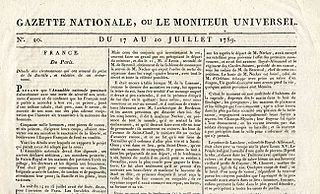
The Mountain was a political group during the French Revolution. Its members, called the Montagnards, sat on the highest benches in the National Convention. The term, first used during a session of the Legislative Assembly, came into general use in 1793. By the summer of 1793, that pair of opposed minority groups divided the National Convention. That year, the Montagnards were influential in what is commonly known as the Reign of Terror.

The sans-culottes were the common people of the lower classes in late 18th-century France, a great many of whom became radical and militant partisans of the French Revolution in response to their poor quality of life under the Ancien Régime. The word sans-culotte, which is opposed to "aristocrat", seems to have been used for the first time on 28 February 1791 by Jean-Bernard Gauthier de Murnan in a derogatory sense, speaking about a "sans-culottes army". The word came into vogue during the demonstration of 20 June 1792.

Pierre Bayle was a French philosopher, author, and lexicographer. He is best known for his Historical and Critical Dictionary, whose publication began in 1697. Many of the more controversial ideas in the book were hidden away in the voluminous footnotes, or they were slipped into articles on seemingly uncontroversial topics. Bayle is commonly regarded as a forerunner of the Encyclopédistes of the mid-18th century.

The Edict of Fontainebleau was an edict issued by French King Louis XIV and is also known as the Revocation of the Edict of Nantes. The Edict of Nantes (1598) had granted Huguenots the right to practice their religion without state persecution. Protestants had lost their independence in places of refuge under Cardinal Richelieu on account of their supposed insubordination, but they continued to live in comparative security and political contentment. From the outset, religious toleration in France had been a royal, rather than popular, policy.

Jacques René Hébert was a French journalist and leader of the French Revolution. As the founder and editor of the radical newspaper Le Père Duchesne, he had thousands of followers known as the Hébertists. A proponent of the Reign of Terror, he was eventually guillotined.

Isaac de Pinto was a Dutch merchant and banker of Portuguese Sephardic Jewish origin who was one of the main investors in the Dutch East India Company, as well as a scholar and philosophe who concentrated on Jewish emancipation and national debt. Pinto published mainly in French and once in Portuguese. According to historian Richard Popkin, Pinto "was one of the very few Jews of the eighteenth century, before Moses Mendelssohn, able to operate and express himself in the mainstreams of European culture."

JeanLuzac was a Dutch lawyer, journalist and professor in Greek and History, of Huguenot origin. He was the most influential newspaper editor in the Western world in the years immediately preceding the French Revolution, and his sister Emilie married his fellow Patriot Wijbo Fijnje.

La Gazette, originally Gazette de France, was the first weekly magazine published in France. It was founded by Théophraste Renaudot and published its first edition on 30 May 1631. It progressively became the mouthpiece of one royalist faction, the Legitimists. With the rise of modern news media and specialized and localized newspapers throughout the country in the early 20th century, La Gazette was finally discontinued in 1915.

Johan Valckenaer was a Dutch professor who specialized in Roman law. He was a passionate and combative patriot who promoted the right to bear weapons. In 1787 he went in exile in France and in 1793 he made proposals for a constitutional monarchy. After his return in 1795 he became professor in Constitutional law, a member of National Assembly, a diplomat and financial counsellor.

Le Moniteur Universel was a French newspaper founded in Paris on November 24, 1789 under the title Gazette Nationale ou Le Moniteur Universel by Charles-Joseph Panckoucke, and which ceased publication on December 31, 1868. It was the main French newspaper during the French Revolution and was for a long time the official journal of the French government and at times a propaganda publication, especially under the Napoleonic regime. Le Moniteur had a large circulation in France and Europe, and also in America during the French Revolution.
The Clichy Club was a political group active during the French Revolution from 1794 to 1797.
Gazette d'Amsterdam was one of the most important international European newspapers of the Enlightenment period and a major source of political information. It was a French language bi-weekly newspaper published in Amsterdam from the second half of the 17th century till 1796, during the Batavian Republic.
Courier du Bas-Rhin was one of the leading European papers of the late 18th century and the Enlightenment period. It was published in French language in Kleve (Cleves) (then a Prussian exclave east of the Dutch Republic from 1767.

Newspapers have played a major role in French politics, economy and society since the 17th century.

The Leiden Draft is the translation used in Anglophone historiography of the Dutch-language concept Leids Ontwerp, a draft-manifesto discussed by the Holland congress of representatives of exercitiegenootschappen on 8 October 1785 in Leiden in the context of the so-called Patriot revolution of 1785 in the Dutch Republic. This draft resulted in publication of the manifesto entitled Ontwerp om de Republiek door eene heilzaame Vereeniging van Belangen van Regent en Burger van Binnen Gelukkig en van Buiten Gedugt te maaken, Leiden, aangenomen bij besluit van de Provinciale Vergadering van de Gewapende Corpsen in Holland, op 4 oktober 1785 te Leiden. It contained an exposition of the Patriot ideology and arrived at the formulation of twenty proposals of political reform in a democratic vein.
Antoine Marie Cerisier was a French journalist, politician and historian, who played a role in the Patriot Revolution in the Dutch Republic in 1785–1787, after first having supported the cause of the American Revolution in that country in collaboration with American ambassador John Adams. Later he also played a role in the early years of the French Revolution as a collaborator of Mirabeau. In that capacity he published an extract of the Dutch Leiden Draft, a manifesto that may have influenced the French Declaration of the Rights of Man and of the Citizen.

Elie Luzac was a Dutch jurist, journalist, writer of philosophical, historical and political literature, and book-seller, who was considered an important ideologue of the "democratic wing" of the Orangist movement, both after the Orangist restoration in the Dutch Republic in 1748, and during the Patriottentijd.

The Forbidden Best-Sellers of Pre-Revolutionary France is a 1996 book by literary scholar Robert Darnton. Darnton maps the "forbidden sector" of eighteenth-century French literature, using archival records that showed the popularity of forbidden books including pornography, utopian literature, and a popular genre of slanderous political works. In 1995, the book won the National Book Critics Circle Award for Criticism.

Gazette de Berne was a newspaper published in Bern, Switzerland, from 1689 to 3 March 1798. Officially, the newspaper published in Bern was called Nouvelles de divers endroits from 1689 to 1787 and Nouvelles politiques from 1788 to 1798, but it was known as the Gazette de Berne. From 1677 and up to 1688, another newspaper was published in Bern, named La Gazette, of which only a few numbers survive.















